When you’re doing your site’s SEO, you have to be careful.
The techniques that used to work will now get you penalized.
The techniques that used to be a waste of time are now indispensable.
Given that Google changes its search algorithm frequently, it’s not surprising marketers get confused sometimes.
Speculations about the latest SEO trends run rampant and are a breeding ground for many myths.
For this reason, it’s sometimes difficult to tell fact from fiction.
Of course, the Internet provides the perfect framework for misinformation to spread at an alarming rate.
As a result, many marketers waste their energy and resources implementing useless tactics that don’t get any results.
Or worse, some implement harmful techniques that get them penalized.
It’s a bad deal either way.
To help you avoid making these mistakes we have created a list of the most common SEO mistakes.
Here we go.
1. Spammy Guest Blogging
Matt Cutts came out with an announcement that sent tremors through the web community:
If you’re using guest blogging as a way to gain links in 2014, you should probably stop.
Here’s what happened after he published that blog post: Mayhem. Unleashed.
Guest blogging has been a pillar of content strategists and SEOs for a long time. Was Cutts really pulling the plug on the practice?
Yes and no.
The fact is not a single line of algorithmic code was changed when Cutts clicked “publish” on his post. The panic was overrated. The people who should be scared are the people who are sending emails to me and Cutts asking for guest posts so they can pop in a backlink.
That’s why Cutts rattled his saber against guest blogging. The spammy SEOs had once again twisted a good thing — guest blogging — into a black hat technique.
There is legitimate guest blogging, and then there is spammy guest blogging. We’re major fans of guest blogging, and we still recommend that you practice it, but with caution.
Since guest blogging got the hairy eyeball from Cutts, we think the algorithm will shift to start suppressing spammy guest blogging results. Here’s what the change might look like:
- First, Google will crack down on guest post links that are irrelevant to the site’s theme. For example, you think an auto insurance sales links on forbes.com/technology is a good idea? Not going to happen.
- Second, Google will tighten the penalties on optimized anchors in guest posts. Optimized anchors are always bad, but it’s likely that the penalties will be swifter and harsher on those that appear in guest blogs.
- Third, Google will increase the algorithmic importance of Google authorship and authority. This is a critical determining factor already. It’s important to keep a pulse on it. In order to look at your own metrics, go to Google Webmaster Tools > Labs > Author Stats. Your personal authority as an author will have an increasing importance upon the validity of your guest blogging.
And if you’re doing any of the following with your guest blogging, we recommend that you stop.
- Using optimized anchors (more on that below) in your guest posts
- Attempting to rank for long tail keywords in your guest posts
- Attempting to rank for head terms in your guest posts
- Writing irrelevant content in your guest posts
- Writing low-quality content in your guest posts
Right now, guest blogging is still a viable option for improving SEO, enhancing brand awareness, and even building your author rank. However, you need to be extremely careful how you execute your guest blogging plan.
Bottom line: Use guest blogging with caution.
2. Optimized Anchors
For a long time, SEOs used anchor texts with keywords to improve their SEO. The great thing was it worked! But the days of optimized anchors are gone. Today, using optimized anchors is like asking for a penalty.
So what’s an optimized anchor? An optimized anchor is an anchor text that uses keywords for which you want to rank. For example, if a site wants to rank for the term “top mobile phone,” it would use the anchor “top mobile phone” to link to its mobile phone site.
It worked great until Google warned against this practice in its “Link Scheme” document.
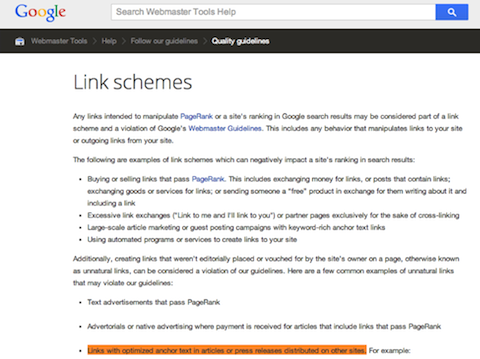
The text reads:
Here are a few common examples of unnatural links that may violate our guidelines…
Links with optimized anchor text in articles or press releases distributed on other sites. For example:
There are many wedding rings on the market. If you want to have a wedding, you will have to pick the best ring. You will also need to buy flowers and a wedding dress.
In other words, don’t optimize anchor texts. We’ve seen optimized anchor texts ruin a site’s SEO through gradual algorithmic penalization. The best we can say about it is that it’s extremely risky.
We know what you are thinking, “Well, what kind of anchors do I use?”
That’s a great question. There are several types of safe anchors that we recommend:
- Naked URLs like this one: www.quicksprout.com
- Branded URLs like this one: For more advice on content marketing, check Quicksprout.
- Long phrases like this one: I’m a major fan of guest blogging, and I still recommend that you practice it with caution.
Links are still important, but their SEO value has more to do with their mere existence than it does with their anchor text.
Bottom line: Use safe anchors, not optimized anchors.
3. Quantity of links over quality
The more backlinks your site gets, the better, right?
No.
Purchasing backlinks is quick, easy, and pretty cheap. You can find any number of SEO agencies who will build a bunch of links for you. In the course of a week or two, they can pile up a few dozen links pointing directly at the pages you specify.
But that could ruin your site, especially if the following is true:
- The site that links is penalized.
- The site that links has a low DA (e.g. below DA 20).
- You receive a large number of such links in a short period of time.
Link building has been and still is the bread and butter of many SEO agencies. However, any SEO value from link building depends upon the authority and validity of the site that is sending the links.
Here’s a quick example. We watched this site languish under a shoddy SEO campaign for months. The SEOs employed by the company were drumming up quick and easy links like crazy. It hurt. Then, when they engaged in an aggressive content marketing campaign with an SEO upside, things changed:

The uptick coincided with a very small number of high-DA backlinks (2 DA 90+ links). The decline coincided with the deluge of low DA backlinks.
According to Search Metrics, the 3rd most determining factor in your rankings is the number of backlinks you have.
Although more backlinks used to mean higher rankings, it’s not necessarily the case anymore. These days, you’ll notice new sites with only a handful of links outranking old authoritative sites.
Why?
Because their backlinks are more relevant. With Google’s Penguin algorithm update, the relevancy of the links is more important than their quantity.
Just look at the example below. We Googled the phrase “business credit cards.” As you can see, Nerd Wallet outranks Chase and American Express sites.
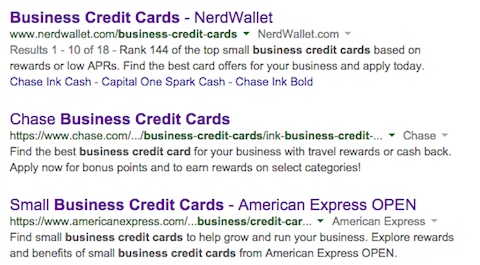
The Nerd Wallet URL in the first position has 176 backlinks from 136 referring domains, according to Ahrefs. The Chase URL has 293 backlinks from 69 referring domains, and the American Express page has 90,000 backlinks from 343 referring domains.
If you look at the root domain names, both Chase and American Express have more links from more unique domains than Nerd Wallet.
According to Google PageRank, Nerd Wallet is at 6, while Chase and American Express are at 7.
This just shows that you don’t need to focus on backlink quantity. Instead, you need to focus on quality links, which is what Nerd Wallet did.
When it comes to your website, don’t try to go after quantity in link building. Focus on building highly relevant links that are topical to the content on your website.
Bottom line: Link building is still alive and well, but don’t try to do it with lots of low-DA backlinks. There is a better way.
4. Keyword Heavy Content
It’s old news that keyword stuffing is bad. This is one of the earliest tricks in the SEO playbook.
Here’s how Google defines keyword stuffing:
“Keyword stuffing” refers to the practice of loading a webpage with keywords or numbers in an attempt to manipulate a site’s ranking in Google search results. Often these keywords appear in a list or group, or out of context (not as natural prose). Filling pages with keywords or numbers results in a negative user experience, and can harm your site’s ranking. Focus on creating useful, information-rich content that uses keywords appropriately and in context.
In spite of the of warnings and consequences of keyword stuffing, we still see it happen.
Here is how Matt Cutts, in a 2011 video, illustrated the effect of adding more and more keywords. Up – plateau – down.

It’s like a bell curve. Add a keyword or two, and you’ll gain some rank. Keep adding keywords, and it doesn’t really add much rank benefit. Keep adding keywords, and you’ll start to lose rank.
In other words, keyword stuff and get penalized.
We want to add something new to this discussion rather than just give you the same worn out warnings. Here are four pieces of advice that will help you avoid keyword-heavy content and produce penalty-free content.
- The kind of keyword stuffing that gets penalized is long tail keywords rather than head terms. For example, “San Francisco hotel vacation cheap” is a long tail keyword. Drop that in your content a few too many times, and a penalty isn’t far behind. However, if you have to use the term “San Francisco” quite a few times, that’s okay.
- Add more content, not just more keywords. The most important thing about keywords is not how many times they occur. I recommend adding more content — both the number of posts and the length of that content. The more pages you have, the more pages on your site will be indexed. When you have lengthy and substantial content on those pages, you’ll have more reader-focused material and related terms.
- Don’t worry about keyword density. Instead, worry about creating really good content for your readers. There was a time when “keyword density” was a big deal. In fact, many SEO writers actually had to run keyword density analyses on their content to make sure that they were in the correct density percentage range. Your goal instead is to shape content for your readers, not the search engines.
- Use related keywords. There’s been some confusion (and change) over the use of latent semantic indexing (LSI) with Google. Whatever Google’s current use of LSI, keep in mind that related keywords are important for both avoiding keyword stuffing and improving your search results. For example, instead of using “San Francisco hotel vacation cheap” a dozen times, you would include natural phrases like “places to stay in the Bay Area” or “lodging near Union Square.”
Bottom line: Go easy on the long tail keywords. Instead, publish more articles with longer content.
5. Relying on link-backs instead of content
Link-backs, while important, are not the only component of SEO. There is a delusion that merely throwing a lot of links to a site will magically bring massive authority, high rankings, and tons of search traffic.
That’s simply not the case.
Truly effective SEO is about the sum of several parts — not one or two techniques pushed to the extreme.
Think about SEO as if it were a fork. A fork doesn’t work if it has just a single tine. A one-tine fork is a spear. A two-tine fork doesn’t work either. Effective forks have several tines — usually four.
SEO is the same way. In order to be effective, you have to use all four components of SEO:
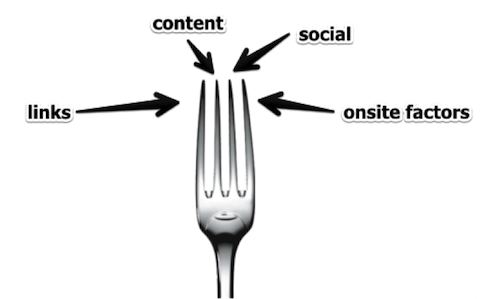
Links are just part of the solution, not the whole thing. You can rack up a huge link profile, but unless you’re advancing your efforts with content marketing, social signals, and solid onsite optimizing (site speed, UI, etc.), you’re wasting your time and money.
Bottom line: Use a link-back strategy, but keep it balanced with the entire suite of SEO — content marketing, social media, and onsite optimization.
6. Building too many links too fast
How many links do you need to build to rank for competitive terms? You actually don’t need too many. What you need is time. Slow and steady is what’s winning the race in the SEO game.
If you look at the Doctor650 site, not only did they not build too many rich anchor text links, but they also didn’t build too many links altogether. We’ve done this with competitive keywords and noticed that the easiest way to climb to the top is to not build too many links. Instead, go for authoritative links.
If you think building a lot of links is better for you, just look at this case study by Marcus Taylor. He built 10,000 links within 24 hours and shot up to a number one ranking on Google, but within three weeks he was pushed down because he built too many links.
Google’s algorithm is sophisticated because they know at what rate websites typically build links. If your link count is growing at an unnatural pace, you won’t rank too well.
7. Building too many links to your homepage
Have you ever looked at the link profile of other sites in your space? What portion of their links are from .gov and .edu sites? What portion of their links is going to their homepage versus internal pages?
Instead of building links to your homepage, consider building links to the majority of your internal pages. Just look at the Wikipedia site that ranks for almost every term out there and is the 6th most popular site in the world.
Majestic SEO is showing that Wikipedia in total has over 600 million backward links, whereas the homepage has roughly six million links. That means 1% of their total links point to their homepage, while 99% go to internal pages.
If you want high rankings, consider building more links to your internal pages versus your homepage.
8. Writing a lot of mediocre content
Have you ever read the content on sites like eHow? They have over five million pages of content; they rank for a lot of terms on Google; and they have millions of backlinks.
Although they do well, it’s not worth copying their content strategy. Why? It’s because their content is mediocre and not detailed. For example, if you Google, “How to install a bidet” this page from eHow ranks in the top ten.
Do you see the problem?
That page does a terrible job explaining how to install a bidet. If eHow wrote articles that were over 2,400 words that were very detailed like Wikipedia’s, they would rank much higher and get more traffic.
Based on this article, you can see why Google prefers to rank web pages with at least 2,000 words of content on page one.
9. SEO is about writing keyword-rich content
If you want to rank for a term like “business credit cards,” you would need that phrase on your web page, right? That used to be the case, but Google’s algorithm uses latent semantic indexing.
Latent semantic indexing (LSI) is an indexing and retrieval method that uses a mathematical technique called singular value decomposition to identify patterns in the relationships between the terms and concepts contained in an unstructured collection of text. LSI is based on the principle that words that are used in the same contexts tend to have similar meanings.
In other words, Google sees the phrase “corporate credit card” as being similar to “business credit cards.” That means if you use the word “corporate” instead of “business,” you would still rank for both terms.
Instead of trying to write keyword-rich content, write content that is user-friendly. If you put your users first and you write what’s best for them, Google will naturally figure out what terms you should rank for and will place you there.
Plus, no one wants to read keyword-rich content. If we mentioned the word “SEO” 100 times within this post because we want to rank for SEO, you’d get tired of reading Quick Sprout and probably stop linking to the site, which would hurt my rankings.
Avoid writing keyword-rich content as it doesn’t help with rankings anymore.
10. SEO is just links, code, and content
That’s what SEO used to be 5 years ago. The sites with mediocre content, tons of links, and good on-page optimization used to rank well.
That’s not the case anymore. These days the sites that do well tend to also have a large social following.
Whether you believe or not that social media has a direct or indirect impact on rankings, it does impact rankings.
Why?
The more popular your site is on the social web, the more eyeballs you will draw to it. And the more people see it, the more backlinks it’ll get.
Plus, social media is a great way to seed content and get the initial traction you are looking for.
If you want better rankings, don’t just focus on link building. Also focus on building up your social profiles.
11. More pages means more traffic
Wikipedia is a great example of a content rich site that gets more traffic. So, if you want more traffic you should create more pages, right?
If the pages aren’t high in quality, you won’t rank well. Instead of actually helping you, adding too much content, especially mediocre content, can hurt you.
Google released an update called Panda, which targeted sites with low quality content. Such sites got penalized, and their search traffic dropped.
A good example of this is Wise Geek. They once dominated the rankings due to their large quantity of content, but they got hit hard by Google’s Panda update due to low quality content.
Don’t create sites with thousands of pages. Focus on creating high quality content. KISSmetrics and Quick Sprout are great examples of this. Both blogs can generate well over a half a million visitors a month, and neither of them have thousands of blog posts.
12. You need a lot of text to rank well
Data has shown that you need to write 2,000 words on each web page if you really want to rank well. But Upworthy has proven the data wrong.
It’s one of the fastest growing content sites on the web, and it’s beaten out Huffington Post and Buzz Feed in growth rate. Yet, it has very little content per page.
Just look at this page on tattoos:

That’s literally all the text the page has. Yet, it ranks at the top of page 2 for the keyword “tattoos”.
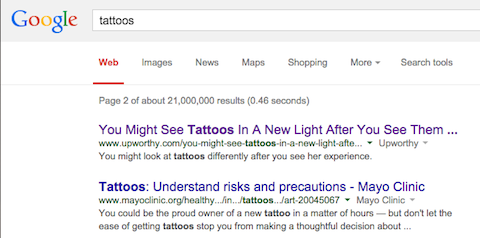
And that’s not the only keyword the website ranks for. According to SEMrush, it gets up to 750,000 visitors a month from search engines.
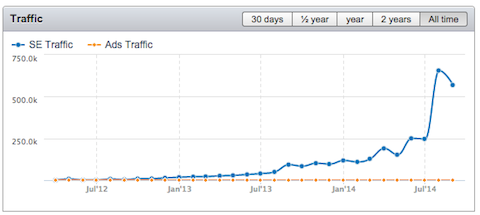
This shows that text isn’t the only form of valuable content. Videos and images also do well in the rankings, which is what Upworthy typically uses within its posts.
If you want high rankings, use different types of content to reach this goal. From podcasts to videos and quizzes, the possibilities are endless.
13. It’s good to let authority sites republish your content
Typically, when an authority site that’s bigger than yours republishes your content, it is a good thing. You get a link back, and you generate traffic and maybe even sales.
The issue with having your content republished is that it creates duplicate content. Even if that authority site links back to you, search engines like Google will rank the authority site above yours. What’s even worse is that you can potentially get hit by a Panda penalty.
Just look at the KISSmetrics blog. We got hit by a Panda penalty for this.
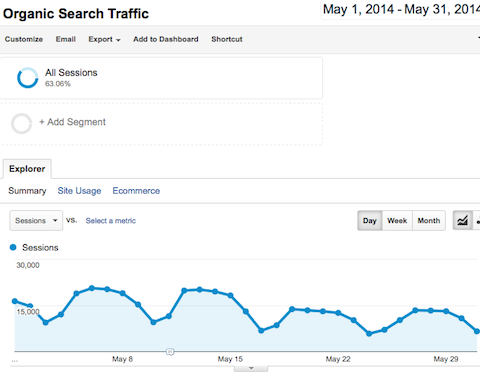
As you can see from the graph above, we saw a 29% drop in traffic because we let authority sites republish our content.
Nonetheless, this is still a great tactic to leverage if you can get authority sites to follow one rule. They need to use a canonical tag that points back to your URL. This is the only way to ensure you don’t get penalized for duplicate content.
14. Bad links will hurt your rankings
When Google released its disavow tool, a lot of marketers went overboard. They felt every bad link was going to hurt their rankings. To some extent they were right: bad links can indeed hurt your rankings, but it happens in rare circumstances.
What Google is trying to do is stop the manipulation of its algorithm through link building.
A lot of the low quality links that point back to your website will be from low-quality aggregator sites. You can try to stop some of these sites by using services like Cloudflare, but don’t get paranoid and start disavowing every link you are not fond of.
The bigger your site, the more junk sites will naturally link to you. In general, you shouldn’t encourage these links, but there isn’t much you can do. Of course, you can disavow each link, but it is rare that these aggregator sites will get you penalized.
Just look at Quick Sprout. We have over 144,000 backlinks from 10,000 unique domains. Out of those links, 581 are coming from low-quality aggregator sites. In the seven-year history of Quick Sprout, it’s never gotten penalized for it.
Instead of worrying about these low quality links, focus your time on creating a good product/service and writing exceptional content. While you are at it, don’t buy links with the intent of manipulating rankings.
15. You shouldn’t buy links
Sure, search engines don’t want you to buy links because this tactic can manipulate rankings, but this doesn’t mean you shouldn’t buy them.
Links are a great way to drive revenue to your business. For example, we bought over $10,000 worth of links and ads from CSS galleries to Crazy Egg before we launched. This resulted in an increase in monthly recurring income of over $2,000. To this date, some of those customers are still with us, which means our link-buying approach was profitable.
How do you buy links without ticking off the search engines? You follow the links. This way, you are telling the search engines not to count the links with no damage to your SEO, but you can still gain traffic and revenue.
16. The higher your bounce rate, the lower your rankings
The one thing we know better than anything else is analytics. We’ve co-founded two analytic companies, and we’ve helped hundreds of companies grow their businesses through analysis.
A lot of marketers claim that the higher your bounce rate is, the lower your rankings will be. For this reason, you need to reduce your bounce rate, right?
Having a lower bounce rate is typically a good thing, but it doesn’t mean you will have higher rankings. In our experience working with various sites, such as TechCrunch, Gawker Media, Amazon, and Microsoft, we saw no correlation between bounce rates and rankings.
Granted, this could be because a lot of the businesses we’ve worked with are large, but even with the small ones, we didn’t notice a huge difference in search traffic as bounce rates changed.
17. A/B testing can hurt your rankings
If A/B testing was so bad, do you think Google would offer A/B testing solutions? Just look under the Content Experiments section within Google Analytics. It is their version of A/B testing.
Sure, you may be creating duplicate content temporarily, but the potential increases in conversions make up for it. Plus, out of all the A/B tests we’ve run, we’ve never seen our traffic drop.
We continually A/B test it and do so with all of our other businesses as well. We can tell you with 100% confidence that we have never seen a dip in rankings due to testing.
If you are worried, you can always noindex the variation to prevent duplicate content.
18. Keyword density is a huge ranking factor
Remember the days when jam-packing content with a targeted keyword phrase would send it soaring to the top of the SERPs?
Kind of like this monstrosity:
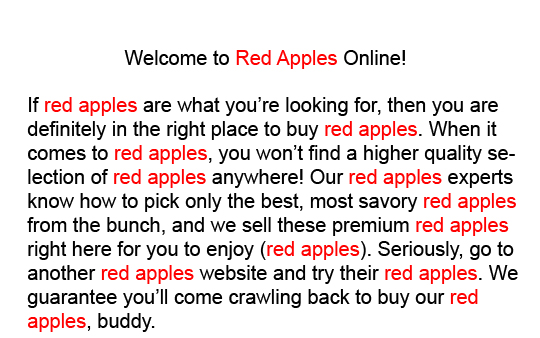
It made for some lackluster content and provided very minimal (if any) real value to readers.
Thankfully, those days are long gone.
Panda put an end to that back in 2011.
Since then, any SEO marketer in their right mind made sure they weren’t doing any keyword stuffing.
But here’s the thing.
It left a lot of questions regarding proper keyword density.
Obviously, keyword stuffing is a bad idea. That’s a given.
But many SEO marketers still seem to think that keyword density is a huge ranking factor.
They end up putting a lot of time and effort into getting it just right.
Just hit that perfect keyword density, and you’re good to go.
But this isn’t the case.
While it is true that keyword density is a ranking factor, it’s by no means as important as it once was.
There’s no reason to stress about it.
It’s something that you should be conscious of, but it shouldn’t command all your attention.
In other words, there’s no need to drive yourself crazy trying to reach the optimal keyword density.
This line from Backlinko summarizes it perfectly:

19. You have to use exact match keywords
There’s another keyword-related myth we would like to put to rest.
And that’s the idea that you should use only exact match keywords.
Let me reference the red apples example one more time:

Beyond the annoying keyword stuffing taking place here, take a look at how every use of the keyword is an exact match.
It sounds ridiculous and unnatural!
That’s not how humans talk.
If it’s unnatural, it’s not adding quality.
And if it’s not adding quality, it’s not contributing to the user experience.
The bottom line is you should use exact match keywords only when it makes sense and sounds natural.
If it makes your content sound clunky, you’ll want to ditch it or use a variation of the keyword.
The concept of always using exact match keywords is extremely antiquated and dates back to when keyword stuffing was acceptable.
But neither has a place in current SEO best practices.
20. Pop-ups are an automatic deal breaker
In January 2017, Google launched an update known as the “Intrusive Interstitial Penalty.”
Here’s a snippet from the Google Webmaster Blog regarding this update:
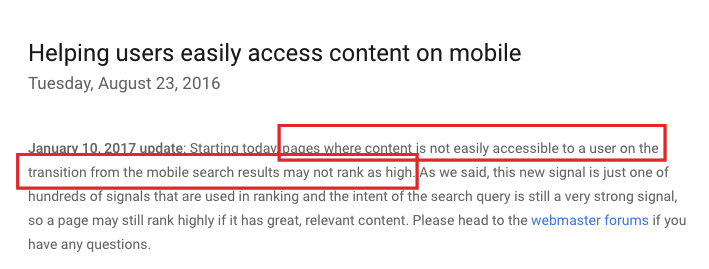
The primary purpose was to provide a better experience for mobile users, ensuring their browsing doesn’t get disrupted by ungodly pop-ups like these:
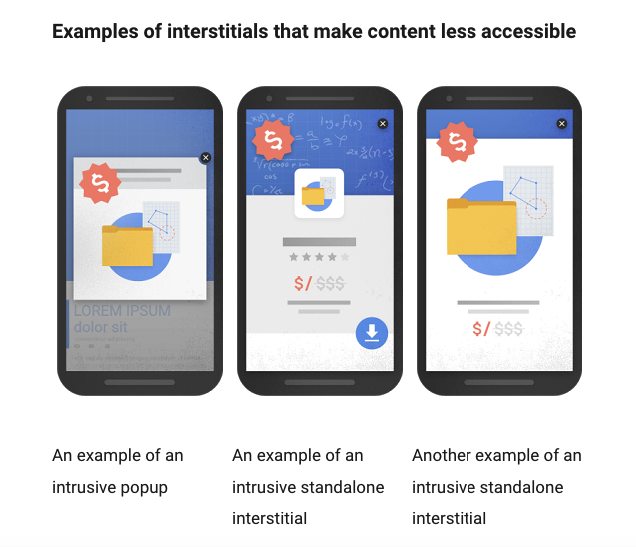
This created an uproar in the SEO community with people being deathly afraid to use any type of pop-up on their sites.
And it’s easy to see why.
Why would you want to risk it?
It was an update for which Google gave a warning several months in advance, which in and of itself is pretty rare.
We even wrote an article in late 2016 called “What Are Interstitials, and Are They Hurting Your SEO?” to give our readers advanced warning.
At the time, it seemed like a very legitimate concern.
But now that some time has passed and the dust has settled, it appears it’s not that big of a deal after all.
Most experts agree:

And we can’t even begin to tell you the number of pop-ups we still get hit with whenever we’re exploring the web or doing research.
In fact, we are a little disappointed because we hate being disrupted by mindless pop-ups when we are in the zone and trying to find important information.
Apparently, having pop-ups on your site isn’t the kiss of death.
But if you do decide to use them, be responsible about it.
Don’t go out of your way to interrupt the user experience, and try to make pop-ups as seamless as possible.
21. It’s all about inbound links
We all know links are super important.
We’ll be the first to say a great looking link profile is a thing of beauty.
But it seems too many marketers are too fixated on just inbound links and forget about outbound links.
Of course, you want authoritative and relevant sites to link to you!
But don’t ignore outbound links:

We mentioned in another post that “outbound links or links that point to external web pages from your own site can actually impact your blog authority. Make sure the pages your links point to are relevant, useful and have good standing with Google.”
And there are plenty of experts who agree.
In fact, Backlinko listed outbound link quality as #31 of Google’s 200 ranking factors.

That’s fairly high.
But isn’t it a disadvantage when people exploring your site are directed to an external site?
Wouldn’t it adversely affect your bounce rate and average time spent on your site, not to mention your conversions?
Well, as we all know, Google’s top priority is an awesome user experience and great content.
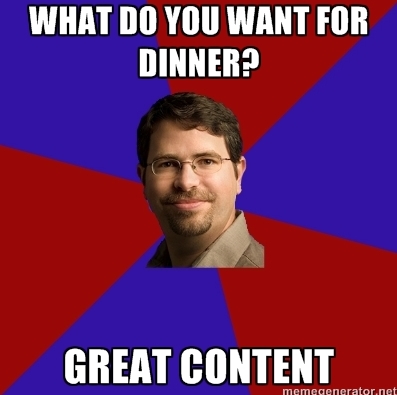
If you include super helpful outbound links that expand on a topic, you’ll be rewarded.
What we’re trying to say here is all links are important.
Instead of focusing solely on acquiring inbound links, you should link out to awesome resources as well.
Make it a habit.
Note: make your outbound links open in a separate tab. This increases the chance that readers will return to your site, and we find it creates an overall better user experience.
22. Jamming your site with affiliate links is no big deal
Ah…affiliate links.
What website owner/blogger wouldn’t want to cash in on them?
It’s one of the most efficient ways to get a nice payday with minimal energy expended.
Don’t get me wrong, we like affiliate marketing. We really do.
In fact, a lot of people completely crush it with affiliate marketing.
Just take a look at what Pat Flynn of Smart Passive Income made in a single month:
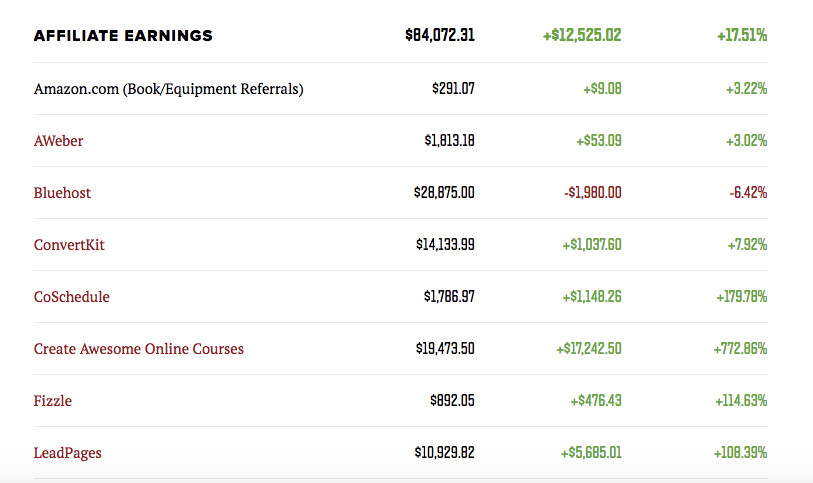
This isn’t to say that making over 80 grand in a month is the norm.
But it does go to show the potential affiliate marketing has.
So, of course, some people will go overboard and stuff their content with affiliate links, assuming it’s no big deal.
And this might have been the case a year ago.
But if you’re familiar with the Google “Fred” update that took place in March 2017, you know going crazy with affiliate links is tempting fate.
Barry Schwartz of Search Engine Land took the time to analyze roughly 100 sites affected by the update, and here’s what he found:
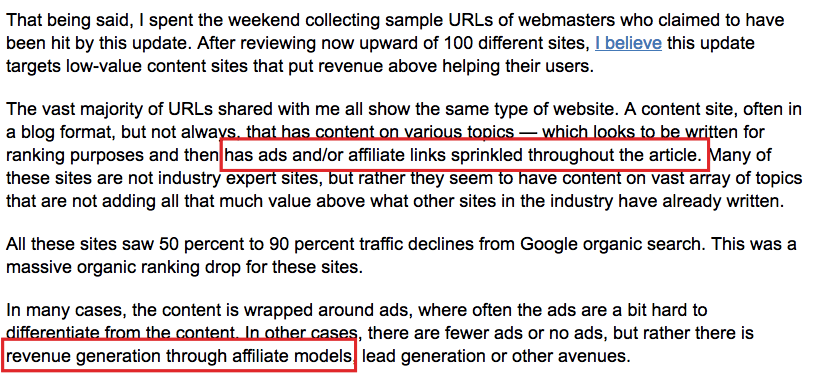
We would say experiencing a 50-90% drop in traffic is cause for concern, and you should proceed with caution for the foreseeable future.
This isn’t to say including a few affiliate links here and there will kill your traffic, but it’s definitely something to be aware of.
Having an abundance of affiliate links signals to Google that making affiliate sales is the main purpose of your content, which could negatively affect your rankings.
23. Title tags and meta descriptions do matter
During all the years we have been doing SEO, we have noticed one commonly repeated mistake. You take title tags and meta description tags for granted.
Now, before we go into the simple title tag and meta description optimization techniques we use, we want to ask you one favor: don’t take them for granted. We used these simple tactics on sites like Gizmodo, TechCrunch, Mashable, and around 30 other of the top 100 blogs on the Internet and saw their traffic go up drastically.
- Your title tags have to be unique on every page and around 60 characters.
- Do not include your website name in all of your title tags as this makes them seem duplicate. Just include your website name in the title tags for your homepage, about page, contact page, and other generic pages.
- Your meta description tag needs to be unique, represent the content on the page (don’t just stuff it with keywords), and contain around 25 or so words.
Try making those changes to your title tags and meta descriptions. If you already have a good number of links coming into your website matched by a decent number of pages, you’ll notice that those changes can double your traffic like it did for TechCrunch. But if you don’t have that much traffic or links coming in, you won’t notice a big impact in your search engine traffic.
Conclusion
Let’s be honest.
SEO can be maddening at times.
There are always some kind of adjustments being made to Google’s algorithm.
Some are major; some are minor. But this constant tweaking often leads to speculation.
This speculation leads to rumors, and rumors lead to persistent myths.
That’s why we thought we would clear the air about some of the most pervasive SEO trends that are actually quite useless.
We hope that putting things into perspective for you will help you focus on what really matters and help you avoid investing your time and energy into tactics that won’t bring any results.
It should also reduce your odds of incurring any ugly penalties.
